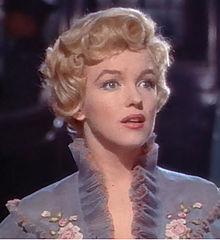Marilyn Monroe
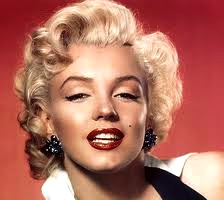
Marilyn Monroe: The Final Days
Director : Patty Ivins Specht, Producers : Patty Ivins Specht, Erika Schroeder, Jason Fine, Kevin Burns, Michael D. Stevens, Writer : Monica Bider, Narrated By James Coburn. In The Final Days, Producer-Director Patty Ivins Chronicles Marilyn Monroe’s Final, Aborted Feature Film, Something’s Got to Give, Which Was Ultimately Shut Down After The Star Was Dismissed From The Production. Beyond Monroe’s Fragile Emotional And Physical Health, This Well-Crafted Profile Examines The Financial Crisis Facing Her Studio As Well As The Mounting Frustration Of Meticulous Director George Cukor And His Cast, Including Costar Dean Martin, As Monroe’s Absences Drove The Shoot Over Budget. The 2001 Documentary, Which Was Previously Available Only As Part Of The Diamond Collection, Concludes With A 40-minute Reconstruction Of Footage Completed For The Feature, Which Would Subsequently Be Reshot As A Vehicle For Doris Day And James Garner, Move Over, Darling. –Sam Sutherland.
Monroe in The Prince and the Showgirl (1957)
Marilyn Monroe (born Norma Jeane Mortenson; June 1, 1926 – August 5, 1962) was an American actress, model, and singer, who became a major sex symbol, starring in a number of commercially successful motion pictures during the 1950s and early 1960s.
After spending much of her childhood in foster homes, Monroe began a career as a model, which led to a film contract in 1946 with Twentieth Century-Fox. Her early film appearances were minor, but her performances in The Asphalt Jungle and All About Eve (both 1950), drew attention. By 1952 she had her first leading role in Don’t Bother to Knock and 1953 brought a lead in Niagara, a melodramatic film noir that dwelt on her seductiveness. Her “dumb blonde” persona was used to comic effect in subsequent films such as Gentlemen Prefer Blondes (1953), How to Marry a Millionaire (1953) and The Seven Year Itch (1955). Limited by typecasting, Monroe studied at the Actors Studio to broaden her range. Her dramatic performance in Bus Stop (1956) was hailed by critics and garnered a Golden Globe nomination. Her production company, Marilyn Monroe Productions, released The Prince and the Showgirl (1957), for which she received a BAFTA Award nomination and won a David di Donatello award. She received a Golden Globe Award for her performance in Some Like It Hot (1959). Monroe’s last completed film was The Misfits, co-starring Clark Gable with screenplay by her then-husband, Arthur Miller.
The final years of Monroe’s life were marked by illness, personal problems, and a reputation for unreliability and being difficult to work with. The circumstances of her death, from an overdose of barbiturates, have been the subject of conjecture. Though officially classified as a “probable suicide”, the possibility of an accidental overdose, as well as of homicide, have not been ruled out. In 1999, Monroe was ranked as the sixth greatest female star of all time by the American Film Institute. In the decades following her death, she has often been cited as both a pop and a cultural icon as well as the quintessential American sex symbol.
Early work: 1945–1947
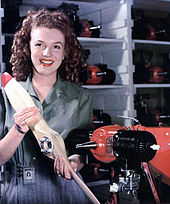 Mrs James Dougherty, June 26, 1945
Mrs James Dougherty, June 26, 1945
While Dougherty served in the Merchant Marine, his wife began working in the Radioplane Munitions Factory, mainly spraying airplane parts with fire retardant and inspecting parachutes. During that time, David Conover of the U.S. Army Air Forces’ 1st Motion Picture Unit was sent to the factory by his commanding officer, future U.S. president Captain Ronald Reagan to shoot morale-boosting photographs for Yank, the Army Weekly magazine of young women helping the war effort. He noticed her and snapped a series of photographs, none of which appeared inYank magazine, although some still claim this to be the case. He encouraged her to apply to The Blue Book Modeling Agency. She signed with the agency and began researching the work of Jean Harlow and Lana Turner. She was told that they were looking for models with lighter hair, so Norma Jeane bleached her brunette hair a golden blonde.
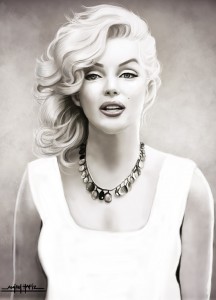 Norma Jeane became one of Blue Book’s most successful models; she appeared on dozens of magazine covers. Her successful modeling career brought her to the attention of Ben Lyon, a 20th Century Fox executive, who arranged a screen test for her. Lyon was impressed and commented, “It’s Jean Harlow all over ag She was offered a standard six-month contract with a starting salary of $125 per week. Lyon did not like the name Norma Jeane and chose “Carole Lind” as a stage name, after Carole Lombard and Jenny Lind, but he soon decided it was not an appropriate choice. Monroe was invited to spend the weekend with Lyon and his wife Bebe Daniels at their home. It was there that they decided to find her a new name. Following her idol Jean Harlow, she decided to choose her mother’s maiden name of Monroe. Several variations such as Norma Jeane Monroe and Norma Monroe were tried and initially “Jeane Monroe” was chosen. Eventually, Lyon decided Jeane and variants were too common, and he decided on a more alliterative sounding name. He suggested “Marilyn”, commenting that she reminded him of Marilyn Miller. Monroe was initially hesitant because Marilyn was the contraction of the name Mary Lynn, a name she did not like. Lyon, however, felt that the name “Marilyn Monroe” was sexy, had a “nice flow,” and would be “lucky” due to the double “M.”
Norma Jeane became one of Blue Book’s most successful models; she appeared on dozens of magazine covers. Her successful modeling career brought her to the attention of Ben Lyon, a 20th Century Fox executive, who arranged a screen test for her. Lyon was impressed and commented, “It’s Jean Harlow all over ag She was offered a standard six-month contract with a starting salary of $125 per week. Lyon did not like the name Norma Jeane and chose “Carole Lind” as a stage name, after Carole Lombard and Jenny Lind, but he soon decided it was not an appropriate choice. Monroe was invited to spend the weekend with Lyon and his wife Bebe Daniels at their home. It was there that they decided to find her a new name. Following her idol Jean Harlow, she decided to choose her mother’s maiden name of Monroe. Several variations such as Norma Jeane Monroe and Norma Monroe were tried and initially “Jeane Monroe” was chosen. Eventually, Lyon decided Jeane and variants were too common, and he decided on a more alliterative sounding name. He suggested “Marilyn”, commenting that she reminded him of Marilyn Miller. Monroe was initially hesitant because Marilyn was the contraction of the name Mary Lynn, a name she did not like. Lyon, however, felt that the name “Marilyn Monroe” was sexy, had a “nice flow,” and would be “lucky” due to the double “M.”
Her first movie role was an uncredited part as a telephone operator in The Shocking Miss Pilgrim in 1947, starring Betty Grable. She won a brief role that same year in Dangerous Years and extra appearances in the western film Green Grass of Wyoming starring Peggy Cummins and the musical film You Were Meant for Me starring Jeanne Crain and Dan Dailey. She also won a three-scene role as Betty in Scudda Hoo! Scudda Hay!, starring a young Natalie Wood, but before the film’s release her part was cut-down to a brief one-line scene.
Breakthrough: 1948–1951
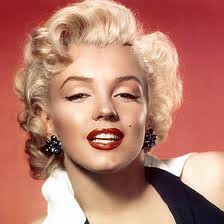 In 1948, Monroe signed a six-month contract with Columbia Pictures and was introduced to the studio’s head drama coach Natasha Lytess, who became her acting coach for several years. Monroe was soon cast in a major role in the low-budget musical Ladies of the Chorus (1948). Monroe was capitalized as one of the film’s bright spots, and the film enjoyed only moderate success. During her short stint at Columbia, studio head Harry Cohn softened her appearance somewhat by correcting a slight overbite she had.
In 1948, Monroe signed a six-month contract with Columbia Pictures and was introduced to the studio’s head drama coach Natasha Lytess, who became her acting coach for several years. Monroe was soon cast in a major role in the low-budget musical Ladies of the Chorus (1948). Monroe was capitalized as one of the film’s bright spots, and the film enjoyed only moderate success. During her short stint at Columbia, studio head Harry Cohn softened her appearance somewhat by correcting a slight overbite she had.
After the release of the poorly reviewed Ladies of the Chorus and being dropped by Columbia, Monroe had to struggle to find work. She particularly wanted film work, and when the offers didn’t come, she returned to modeling. In 1949, she caught the eye of photographer Tom Kelley, who convinced her to pose nude. Monroe was laid out on a large fabric of red silk and posed for countless shots. She was paid $50 and signed the model release form as “Mona Monroe.” This was the only time that Monroe was paid for her nude posing.
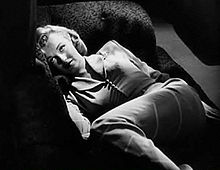 In The Asphalt Jungle (1950)
In The Asphalt Jungle (1950)
Soon thereafter she had a small walk-on role in the Marx Brothers film Love Happy (1949). Monroe impressed the producers, who sent her to New York to feature in the film’s promotional campaign. Love Happy brought Monroe to the attention of thetalent agent, Johnny Hyde, who agreed to represent her. After signing on with Hyde, Monroe had brief roles in three films, A Ticket to Tomahawk, Right Cross, and The Fireball, all of which were released in 1950 and brought no attention to her career. Hyde soon thereafter arranged for her to audition for John Huston, who cast her in the Metro-Goldwyn-Mayer drama The Asphalt Jungle as the young mistress of an aging criminal. Her performance brought strong reviews, and was seen by the writer and director, Joseph Mankiewicz. He accepted Hyde’s suggestion to cast Monroe in a small comedic role in All About Eve as Miss Caswell, an aspiring actress, described by another character, played by George Sanders, as a student of “The Copacabana School of Dramatic Art”. Mankiewicz later commented that he had seen an innocence in her that he found appealing, and that this had confirmed his belief in her suitability for the role. Following Monroe’s success in these roles, Hyde negotiated a seven-year contract for her with 20th Century Fox, shortly before his death in December 1950. It was at some time during this 1949–1950 period that Hyde arranged for her to have a slight bump of cartilage removed from her somewhat bulbous nose which further softened her appearance and accounts for the slight variation in look she had in films after 1950.
In 1951, Monroe enrolled at University of California, Los Angeles, where she studied literature and art appreciation. During this time Monroe had minor parts in four films: the low-budget drama Home Town Story with Jeffrey Lynn and Alan Hale, Jr., and three comedies: As Young as You Feel with Monty Woolley and Thelma Ritter; Love Nest with June Haver and William Lundigan; and Let’s Make It Legal with Claudette Colbert and Macdonald Carey, all of which were filmed on a moderate budget and only became mildly successful. In March 1951, she appeared as a presenter at the 23rd Academy Awards ceremony. In 1952, Monroe appeared on the cover of Look magazine wearing a Georgia Tech sweater as part of an article celebrating female enrollment to the school’s main campus. In the early 1950s, Monroe unsuccessfully auditioned for the role of Daisy Mae in a proposed Li’l Abner television series based on the Al Capp comic strip, but the effort never materialized.
Leading films: 1952–1955
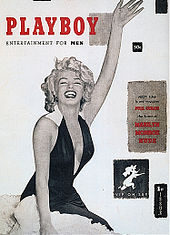 First issue of Playboy, December 1953
First issue of Playboy, December 1953
In March 1952, Monroe faced a possible scandal when one of her nude photos from her 1949 session with photographer Tom Kelley was featured in a calendar. The press speculated about the identity of the anonymous model and commented that she closely resembled Monroe. As the studio discussed how to deal with the problem, Monroe suggested that she should simply admit that she had posed for the photograph but emphasize that she had done so only because she had no money to pay her rent She gave an interview in which she discussed the circumstances that led to her posing for the photographs, and the resulting publicity elicited a degree of sympathy for her plight as a struggling actress.
She made her first appearance on the cover of Life magazine in April 1952, where she was described as “The Talk of Hollywood.” The following year, she was photographed by notedLife magazine photographer Alfred Eisenstaedt, considered “The father of photojournalism.” He photographed Monroe on the patio of her Hollywood home. Many of the images from that sitting have been reproduced in numerous subsequent publications and byLife magazine. Monroe was pleased with his images of her, later telling him, “You made a palace out of my patio.”
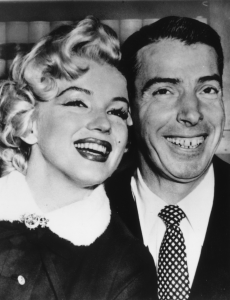 Stories of her childhood and upbringing portrayed her in a sympathetic light: a cover story for the May 1952 edition of True Experiences magazine showed a smiling and wholesome Monroe beside a caption that read, “Do I look happy? I should—for I was a child nobody wanted. A lonely girl with a dream—who awakened to find that dream come true. I am Marilyn Monroe. Read my Cinderella story.” It was also during this time that she began dating baseball player Joe DiMaggio. A photograph of DiMaggio visiting Monroe at the 20th Century Fox studio was printed in newspapers throughout the United States, and reports of a developing romance between them generated further interest in Monroe.
Stories of her childhood and upbringing portrayed her in a sympathetic light: a cover story for the May 1952 edition of True Experiences magazine showed a smiling and wholesome Monroe beside a caption that read, “Do I look happy? I should—for I was a child nobody wanted. A lonely girl with a dream—who awakened to find that dream come true. I am Marilyn Monroe. Read my Cinderella story.” It was also during this time that she began dating baseball player Joe DiMaggio. A photograph of DiMaggio visiting Monroe at the 20th Century Fox studio was printed in newspapers throughout the United States, and reports of a developing romance between them generated further interest in Monroe.
Four films in which Monroe featured were released beginning in 1952. She had been lent to RKO Studios to appear in a supporting role in Clash by Night, a Barbara Stanwyck drama, directed by Fritz Lang. Released in June 1952, the film was popular with audiences, with much of its success credited to curiosity about Monroe, who received generally favorable reviews from critics.

